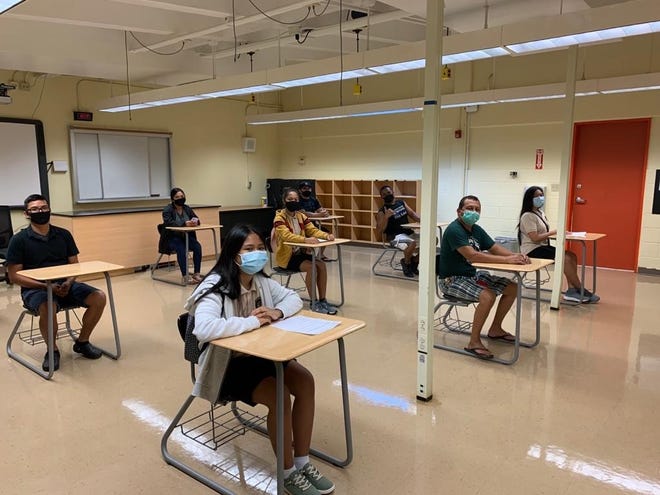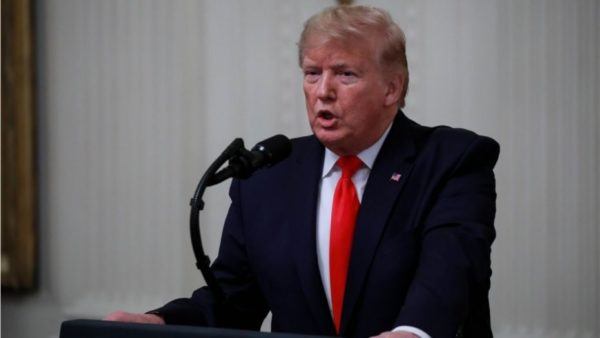Coronavirus cases are soaring across the country and some states are pausing the reopening of their economies. Still, pressure is mounting to reopen schools full-time this fall — and it’s coming from state politicians, the White House, pediatricians and parents.
Teachers are caught in the middle.
While many desperately want to return to their classrooms, they’re worried about putting themselves or their families at risk of getting sick. Nobody knows how likely that will be once adults begin working in close quarters in school buildings again.
This week, that dilemma was thrust to the fore. Before a lengthy White House discussion Tuesday on reopening America’s schools, Florida’s education commissioner on Monday ordered all districts to offer parents the opportunity to send their students back to school five days a week.
‘It’s time to do it’:Trump vows to pressure governors to reopen schools this fall

Teachers’ unions concerned about the health and safety of students and staff have balked at that order, with one Florida union official calling it “catastrophic.” The state continues to set records for daily new infections.
Districts, meanwhile, face another alarming prospect: If millions of students elect to return to class while millions of teachers don’t, it could create a staffing shortage unlike anything seen in modern times.
Nationwide, 1 in 5 teachers said they were unlikely to return to school if their buildings opened this fall, according to a USA TODAY/Ipsos poll in late May.

The White House pressure doesn’t amount to a federal order. Because of the long tradition of local control in American education, superintendents have latitude to determine how to run their schools this fall. One of the most commonly discussed models has students learning in person some days of the week and at home on others, to facilitate physical distancing in school buildings. That’s what the Centers for Disease Control recommended in earlier guidance.
Remote learning:Parents and kids hate online learning. How can we improve it?
At the White House discussion Tuesday, CDC Director Robert Redfield emphasized preventing the spread of the virus in schools primarily through facial coverings and hand-washing.
Education Secretary Betsy DeVos on Tuesday assailed plans to offer in-person instruction only a few days a week. On a call with governors, she said schools must be “fully operational” even amid the coronavirus pandemic.
Anything less, she said, would fail students and taxpayers. Audio of the call was obtained by The Associated Press.
With the sudden attention from President Donald Trump’s administration on reopening schools to their fullest capacity, the already complicated question of how to safely hold classes has become a political issue. Trump has used the issue to go after his likely rival in the 2020 presidential race, former Vice President Joe Biden, as well as other Democrats. On Monday, he said in a tweet that they don’t want to open schools for political reasons.
“A whole kitchen sink of issues are starting to be hitched to the reopening question, and when you couple that with the overlay of a contested election and general toxicity, it’s a recipe for a lot of friction,” said Andy Rotherham, co-founder and partner at Bellwether Education Partners, an education policy think tank in Washington.
“The reopening question, in isolation, is incredibly complicated to start with,” he added.
Districts tell parents: Choose remote or in-person classes
The pile-on from political leaders comes as districts are scrambling to define their instructional plans come fall. Deadlines are looming in places like Fairfax, Virginia, and Marion County, Florida, for parents to choose between in-person or remote learning from home this fall. Districts say the decisions will last a semester or an entire school year, and officials need to know so they can plan for the appropriate staffing.
In Marion County, Florida, which includes Ocala, children whose parents who do not pick an option for instruction for the fall semester by July 15 will be assigned to attend in-person classes at their zoned school. More than 70% of 22,000 parents surveyed said they would send their child to their school campus.
When schools reopen:Scheduled days home, more online learning, lots of hand-washing
Meanwhile, many districts are pushing back their start dates to give themselves more time, which only adds to the uncertainty.
As districts have weighed their reopening options in recent weeks, new research has continued to suggest children are less susceptible to contracting the virus and getting sick from it, compared with adults. And they may not pass it to adults as readily as was once thought.
Last week, the American Academy of Pediatrics recommended schools prioritize in-person instruction, because of the academic, social and emotional costs of keeping kids at home.
On Tuesday during the White House event about reopening schools, Health and Human Services Secretary Alex Azar said as long as people acted with “good individual responsibility,” there’s no reason schools shouldn’t be able to hold in-person classes.
“We have healthcare workers who don’t get infected because they take the right precautions,” he said. “They wear facial coverings and practice good personal hygiene.”

But whether millions of American school staff — much less, children — can faithfully follow such protocols has yet to be tested. Israel fully reopened its schools late this spring and then had to shut them down after two weeks, when hundreds of students and school employees tested positive for the virus.
One of the biggest issues teachers bring up is their safety in the event that a person tests positive for the virus in school, said Khem Irby, a school board member for Guilford County Schools in North Carolina — the state’s third-largest district.
“What does that mean?” asked Irby, who is also president of the national advocacy group, Parents Across America. “Does the whole school close? Is everyone on a 14-day quarantine? We haven’t heard that protocol yet.”
Most state and district reopening plans are not addressing what to do with teachers who are considered vulnerable to dangerous COVID-19 infections, said John Bailey, a visiting fellow at the American Enterprise Institute, a free-market think tank in Washington.
“If teachers feel like the plans are unsafe, it’s impossible to open up schools,” Bailey said.
Teachers wanted respect:It only took a coronavirus pandemic and worldwide economic collapse
Across the country, districts are scrambling not just to fill teaching openings, but also to plan for substitutes. Nicola Soares, president of Kelly Education, a national staffing service that placed around 4 million substitutes last year, said every district she speaks to is anticipating increased staff attrition because of infections, teachers’ ages or underlying health conditions.
“We’re being asked to double or triple the staff we’ve provided them with before,” Soares said. “Our substitute teachers working in a school district are going to be the next essential worker.”
Florida unions balk at reopening schools five days a week
Florida’s education commissioner, Richard Corcoran, issued an emergency order Monday for all schools to offer parents the option of sending their children to full-time school, five days a week.
Local health officials who determine it’s not safe to reopen can override the governor’s mandate. But the directive also raises expectations for remote learning: District plans must use the same curriculum and instructional time as what students would receive if they were learning in-person, the order said.

Teachers’ union leaders in Florida said this week they don’t think the in-person learning plan is safe, especially since the state has seen coronavirus cases explode.
Opening schools under current conditions “could be catastrophic,” said Karen Resciniti, president of the Martin County Education Association. Most educators are hesitant to return to the classroom, even if social distancing is followed and masks are required, she said.
At least three teachers’ union leaders have pleaded to continue virtual learning come August, instead of sending children and staff back to class in their districts.
Districts are slashing budgets, too:Without more coronavirus relief, schools prep layoffs
Other officials said the guidance from the state’s education chief comes too late to be helpful.
“I am disappointed in the commissioner and the governor for waiting until July 6 to send this down after schools have been struggling all summer long to figure out what to do and which direction to go,” St. Johns County School Board member Beverly Slough said at a meeting Tuesday.
Federal and state leaders made a big push to open businesses weeks ago, said Dan Domenech, president of the national School Superintendents Association. Now, certain states — such as Florida, Arizona and Texas — are seeing infection rates skyrocket.
Round two is going to include schools, he said.
“They want the economy to open come hell or high water, and they want people to be free to go to work, and schools are the childcare providers,” Domenech said. “But there’s a total disregard for the health care of staff.”
Contributing: Emily Bloch of the Florida Times-Union; CD Davidson-Hiers of the Tallahassee Democrat; Sommer Brugal of Treasure Coast Newspapers; Joe Callahan of the Ocala Star-Banner.
Education coverage at USA TODAY is made possible in part by a grant from the Bill & Melinda Gates Foundation. The Gates Foundation does not provide editorial input.


